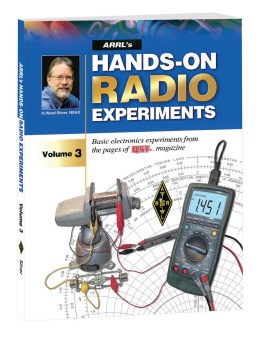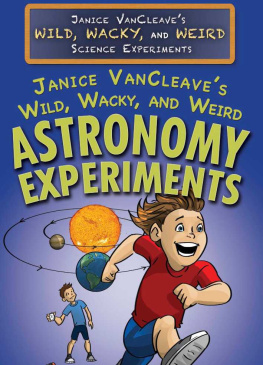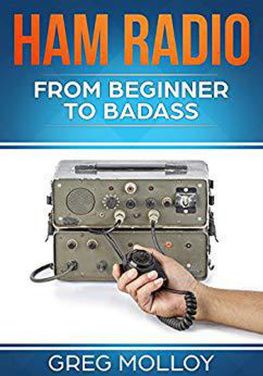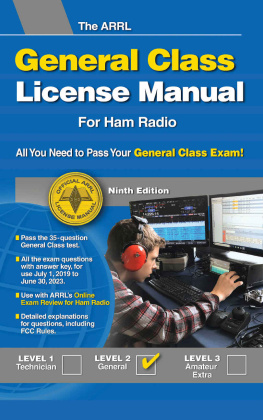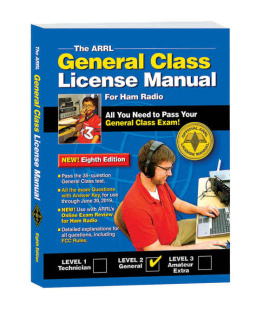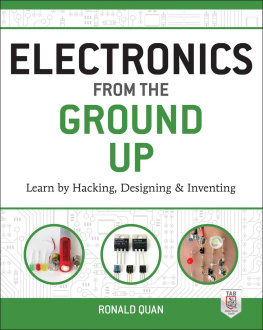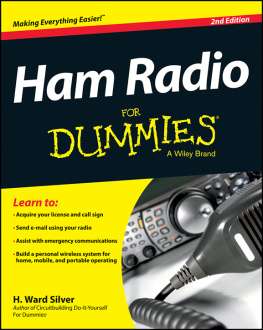Copyright 2018 by
The American Radio Relay League
Copyright secured under the Pan-American Convention
International Copyright secured.
No part of this work may be reproduced in any form except by written permission of the publisher. All rights of translation are reserved.
Printed in USA
Quedan reservados todos los derechos
ISBN: 978-1-62595-0796
First Edition
First Printing
eBooks created by www.ebookconversion.com
Updates

There is often additional information regarding the Hands-On Radio experiments you can find it on the Hands-On Radio Web page at www.arrl.org/hands-on-radio . The contents include links to reference articles and sources of supplies and equipment. There is also a Frequently Asked Questions section that provides explanations about many of the experiments. Readers have contributed their observations and sometimes tools and links that relate to the topic in the experiment. You may find the information helpful as you perform the experiments in this anthology.
Contents
F oreword
Welcome to the third volume of Hands-On Radio Experiments. The companion Volumes 1 and 2 span a 15-year set of columns in QST . When the column started long ago, we werent sure if it would run more than a few months, but readers were certainly interested and here we are, some 179 columns later!
This volume is similar to the previous volumes in that it presents an eclectic mix of topics spanning the practical through theory. There are several columns that describe how components even wires and PC traces behave at RF, which is often quite different from their performance at lower frequencies and dc. Knowing how to account for the difference can make or break a project or repair.
Volume 3 has a bit more emphasis on transmission lines, antennas, and some associated circuit functions. Even if the column doesnt include an experiment per se, be sure to build one or two of the antennas or circuits to see how they work. Then be sure to compare the results to what you expected. Thats a very important part of learning about radio and wireless in general.
The columns on grounding and bonding generated so much interest that I extended the conversation to the recent ARRL book of the same name. This is an area of many mis- and incomplete understandings, which lead to confusion and poor practices. It is the Hands-On Radio readership that deserves a great deal of credit for encouraging me to collect the necessary information and put it into one book where it can serve as a reference and a guide to station and antenna system building.
Finally, the last columns covered that most mysterious of topics, Maxwells equations. With their somewhat advanced notation, they look very intimidating. Ive tried to demystify both the symbols and the concepts, explaining how radio waves appear as a consequence of inconveniencing electrons by accelerating and decelerating them. Since we make use of radio waves in ham radio, it seemed like a good idea for us to understand where they come from!
This volume completes the Hands-On Radio series in its present form. There will be other columns from excellent writers, just as there were in the past. ARRL members will enjoy searching the ARRL archives for columns by legendary writers like George Grammar, W1DF, and Doug DeMaw, W1FB, who were certainly inspirations to me. Or why not write an article yourself? QST is our shared resource and depends on each of us for contributions, as well as readership. If you know a topic well, your first article might be close at hand.
Thanks for reading and 73!
Ward Silver, NAX
About the ARRL
The seed for Amateur Radio was planted in the 1890s, when Guglielmo Marconi began his experiments in wireless telegraphy. Soon he was joined by dozens, then hundreds, of others who were enthusiastic about sending and receiving messages through the air some with a commercial interest, but others solely out of a love for this new communications medium. The United States government began licensing Amateur Radio operators in 1912.
By 1914, there were thousands of Amateur Radio operators hams in the United States. Hiram Percy Maxim, a leading Hartford, Connecticut inventor and industrialist, saw the need for an organization to unify this fledgling group of radio experimenters. In May 1914 he founded the American Radio Relay League (ARRL) to meet that need.
ARRL is the national association for Amateur Radio in the US. Today, with approximately 167,000 members, ARRL numbers within its ranks the vast majority of active radio amateurs in the nation and has a proud history of achievement as the standard-bearer in amateur affairs. ARRLs underpinnings as Amateur Radios witness, partner, and forum are defined by five pillars: Public Service, Advocacy, Education, Technology, and Membership. ARRL is also International Secretariat for the International Amateur Radio Union, which is made up of similar societies in 150 countries around the world.
ARRLs Mission Statement: To advance the art, science, and enjoyment of Amateur Radio.
ARRLs Vision Statement: As the national association for Amateur Radio in the United States, ARRL:
Supports the awareness and growth of Amateur Radio worldwide;
Advocates for meaningful access to radio spectrum;
Strives for every member to get involved, get active, and get on the air;
Encourages radio experimentation and, through its members, advances radio technology and education;
and
Organizes and trains volunteers to serve their communities by providing public service and emergency communications.
At ARRL headquarters in the Hartford, Connecticut suburb of Newington, the staff helps serve the needs of members. ARRL publishes the monthly journal QST and an interactive digital version of QST , as well as newsletters and many publications covering all aspects of Amateur Radio. Its headquarters station, W1AW, transmits bulletins of interest to radio amateurs and Morse code practice sessions. ARRL also coordinates an extensive field organization, which includes volunteers who provide technical information and other support services for radio amateurs as well as communications for public service activities. In addition, ARRL represents US radio amateurs to the Federal Communications Commission and other government agencies in the US and abroad.
Membership in ARRL means much more than receiving QST each month. In addition to the services already described, ARRL offers membership services on a personal level, such as the Technical Information Service, where members can get answers by phone, e-mail, or the ARRL website to all their technical and operating questions.
A bona fide interest in Amateur Radio is the only essential qualification of membership; an Amateur Radio license is not a prerequisite, although full voting membership is granted only to licensed radio amateurs in the US. Full ARRL membership gives you a voice in how the affairs of the organization are governed. ARRL policy is set by a Board of Directors (one from each of 15 Divisions). Each year, one-third of the ARRL Board of Directors stands for election by the full members they represent. The day-to-day operation of ARRL HQ is managed by a Chief Executive Officer and his/her staff.
Join ARRL Today! No matter what aspect of Amateur Radio attracts you, ARRL membership is relevant and important. There would be no Amateur Radio as we know it today were it not for ARRL. We would be happy to welcome you as a member! Join online at www.arrl.org/join . For more information about ARRL and answers to any questions you may have about Amateur Radio, write or call:

